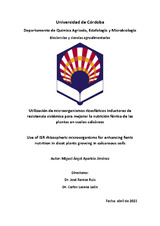Utilización de microorganismos rizosféricos inductores de resistencia sistémica para mejorar la nutrición férrica de las plantas en suelos calcáreos
Autor
Aparicio Jiménez, Miguel Ángel
Director/es
Ramos Ruiz, JoséLucena, Carlos
Editor
Universidad de Córdoba, UCOPressFecha
2023Materia
LithospherePlants
Oxides
Hydroxides
Herbivores
METS:
Mostrar el registro METSPREMIS:
Mostrar el registro PREMISMetadatos
Mostrar el registro completo del ítemResumen
Fe is the fourth most abundant element of the lithosphere. Despite its abundance, it is not always available for plants. At alkaline pH, Fe is mainly present as Fe3+, forming Fe oxides and hydroxides. Plants need to absorb Fe from the soil in the form of Fe2+, which is available at low pH. To solve this problem with Fe availability, dicotyledonous plants, also called strategy I plants, induce a set of physiological responses to obtain Fe from the soil. Under Fe deficiency, plants induce a ferric oxido-reductase at root level that reduces Fe3+ to Fe2+. Also in the root, plants induce a Fe2+ transporter, as well as a proton ATPase that causes rhizosphere acidification through H+ extrusion into the rhizosphere. These responses are modulated by phytohormones such as ethylene, nitric oxide, and auxins. There are certain rhizospheric bacteria and fungi that can elicit a defensive state in the whole plant that confers resistance against pathogens and herbivores, the Induced Systemic Resistance (ISR). When the plant recognizes molecular patterns associated with these microbes (MAMPs), the levels of ethylene and nitric oxide, hormones that trigger this defensive mechanism, increase within the plant. Fe deficiency responses and ISR are modulated by these phytohormones. Similarly, these two responses also share other regulators such MYB72 transcription factor. In this work, in vitro, hydroponic and substrate culture assays were carried out with Arabidopsis thaliana, tomato and cucumber seedlings inoculated with the WCS417 strain of Pseudomonas simiae or the FO12 strain of Fusarium oxysporum in order to test the ability of these microorganisms to enhance Fe deficiency responses. Our results showed that both strains are able to induce both physiological and morphological mechanisms related to Fe deficiency responses, such as enhancement of ferric reductase activity, NO formation at the subapical region of the root, lateral roots formation, increase of leaf chlorophyll levels in Fe deficiency, induction of Fe-related genes and ethylene-related genes and promotes growth of cucumber, tomato and A. thaliana plants cultured in different conditions.

